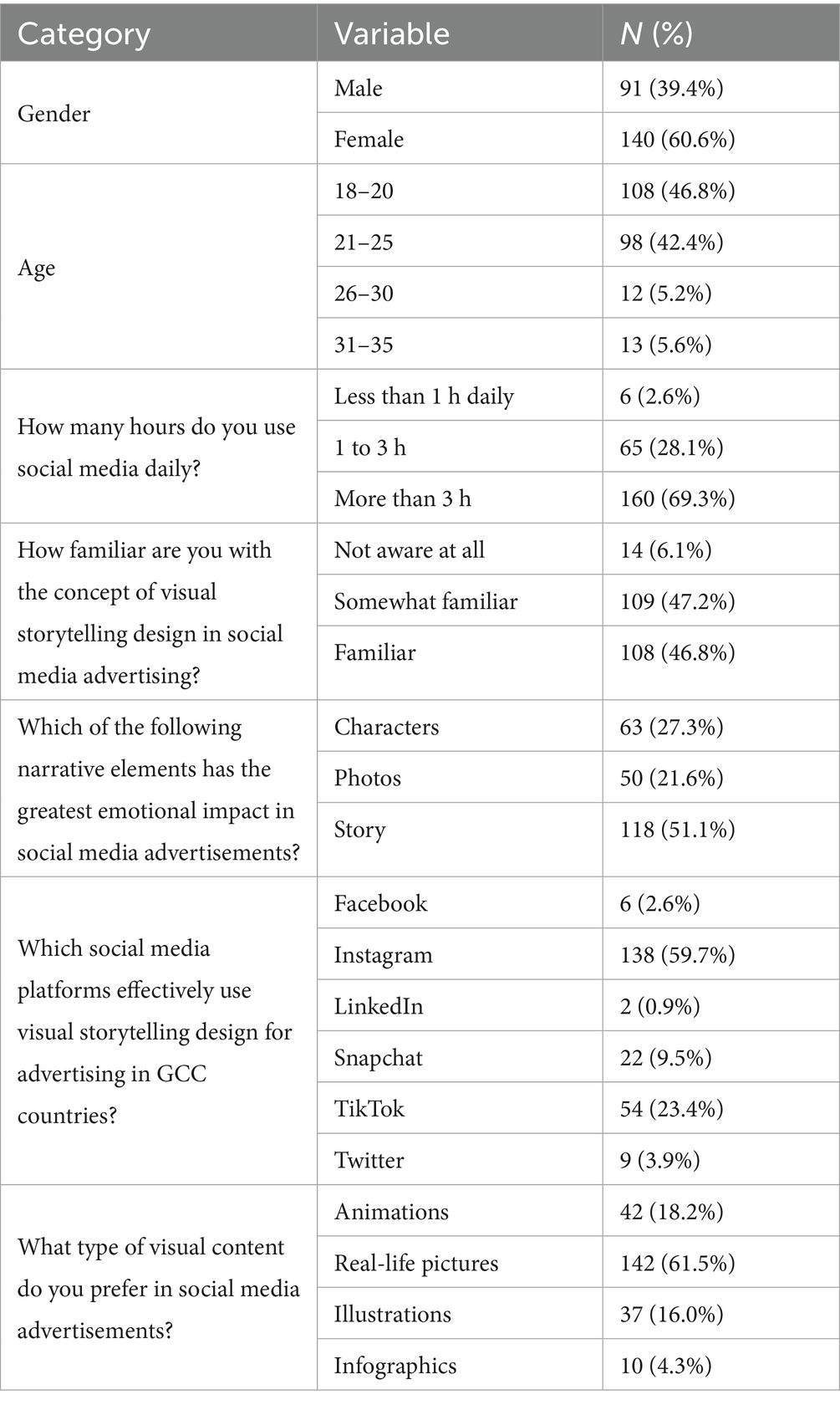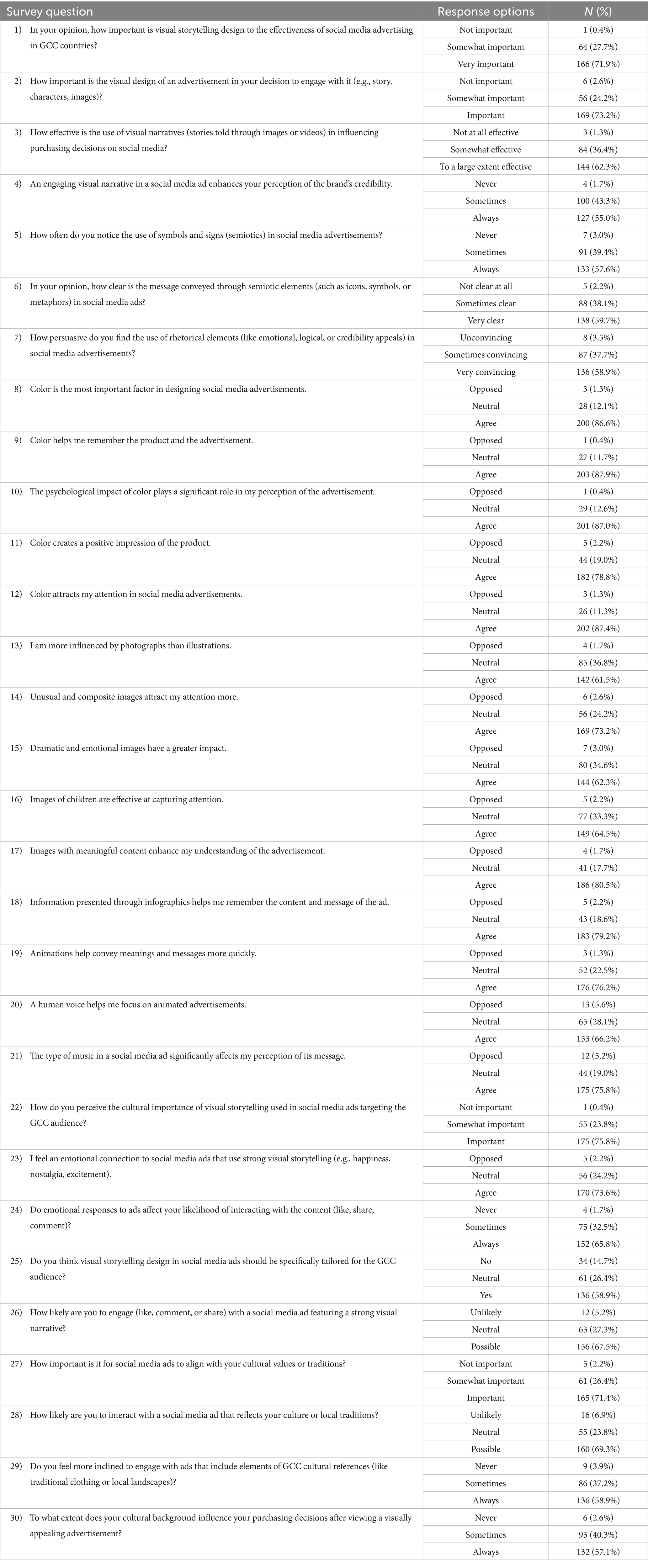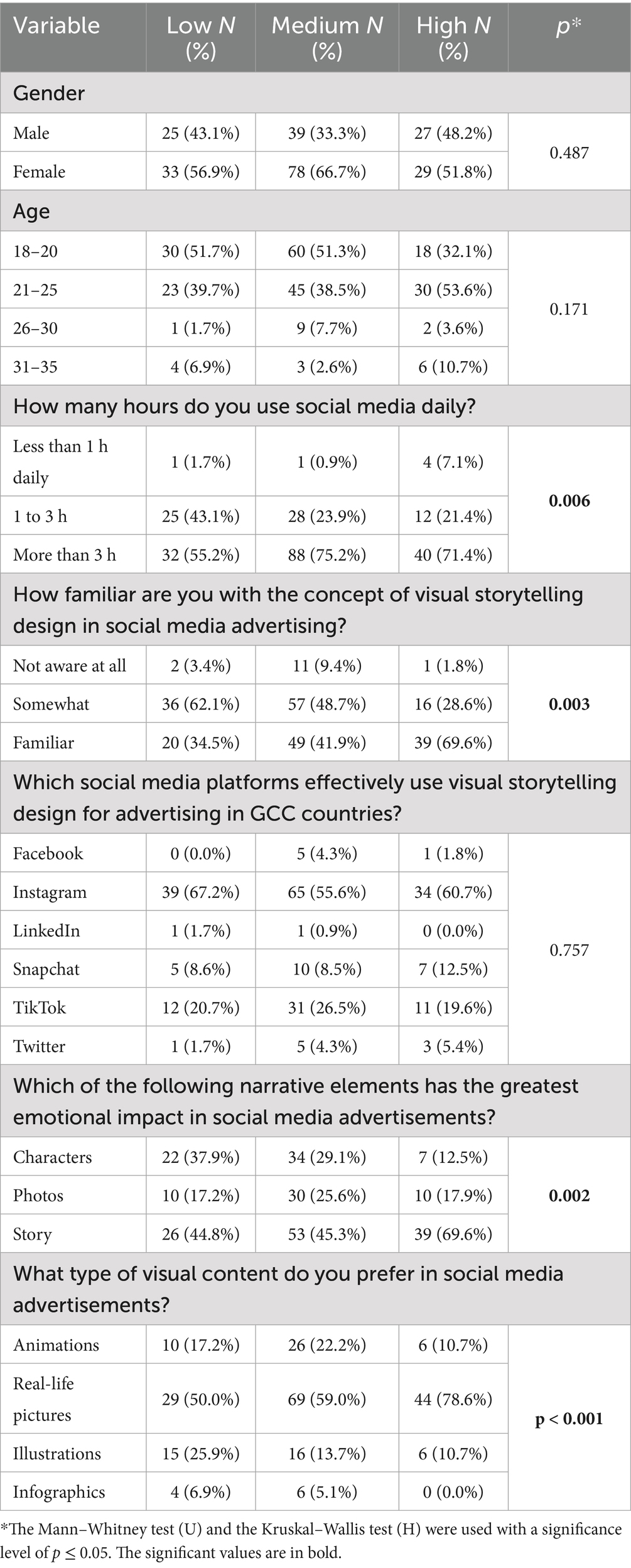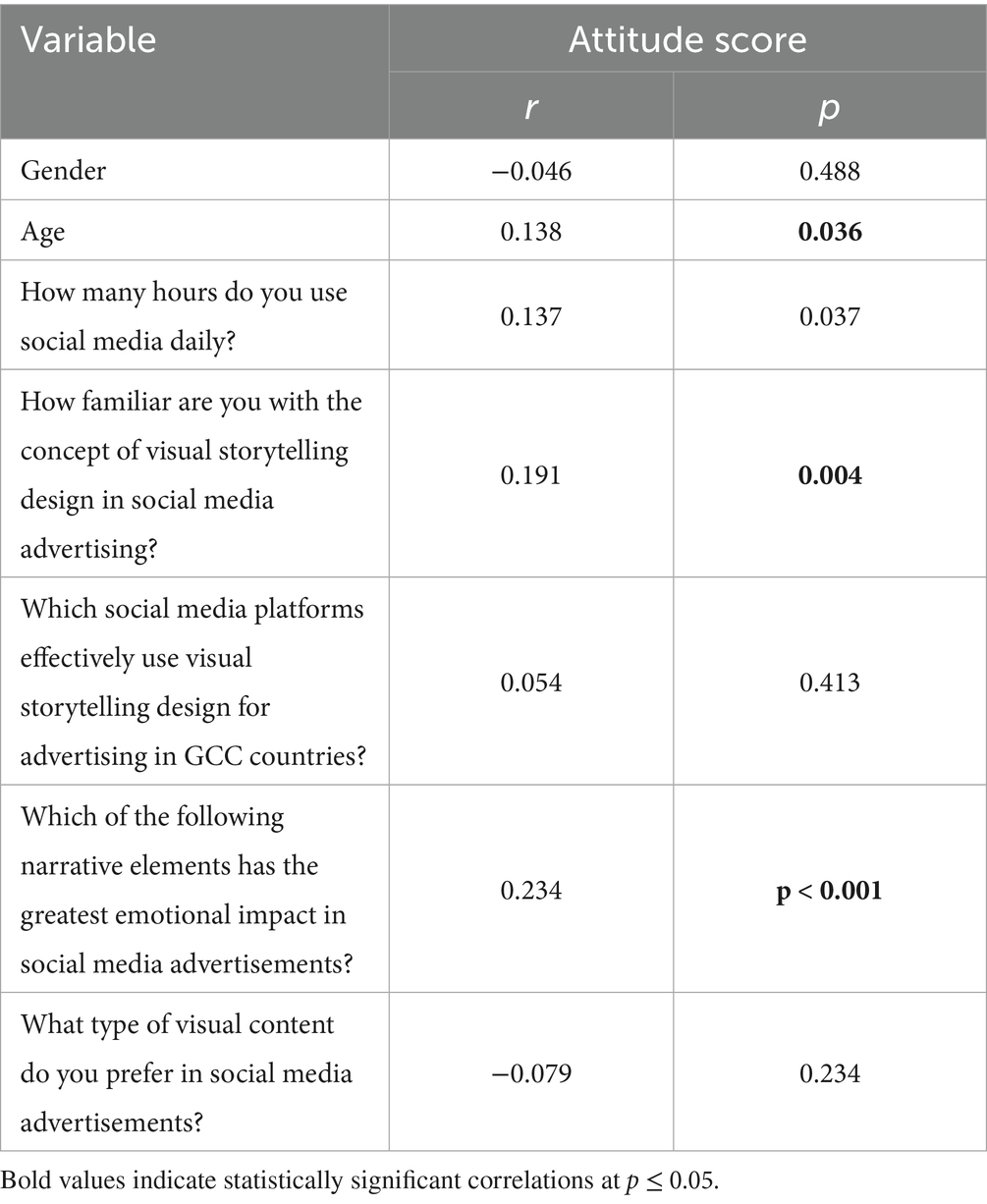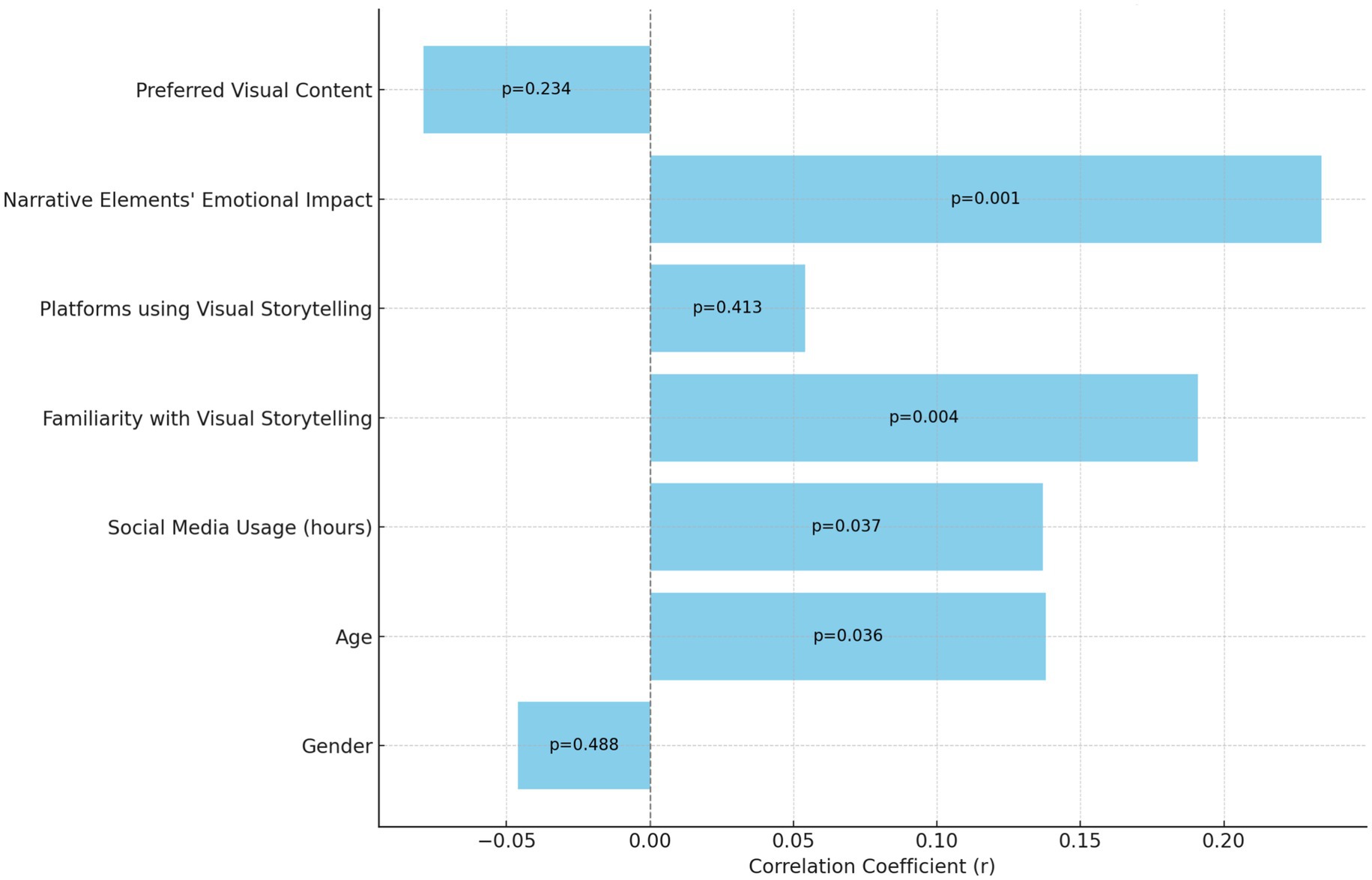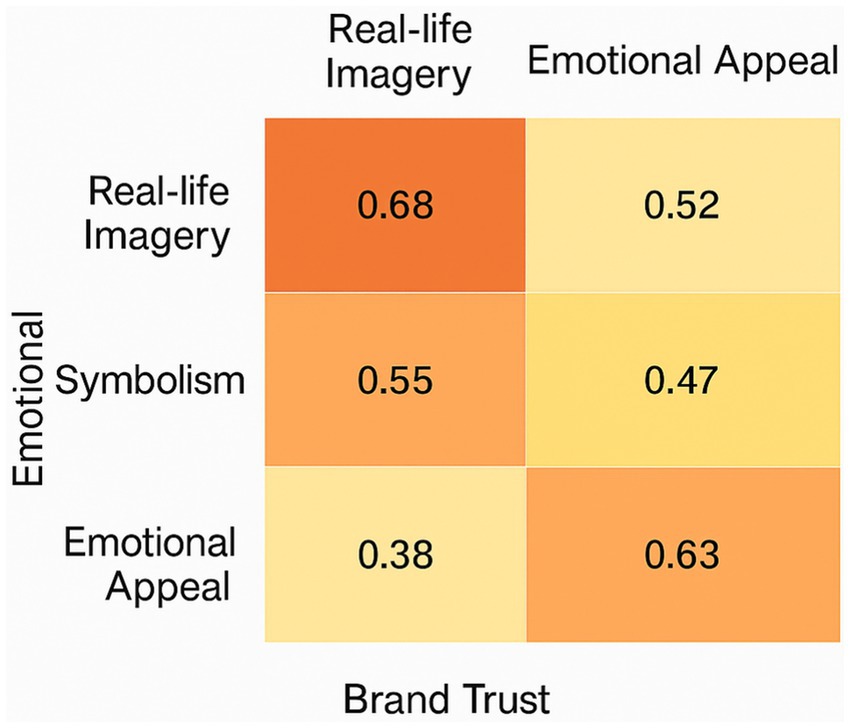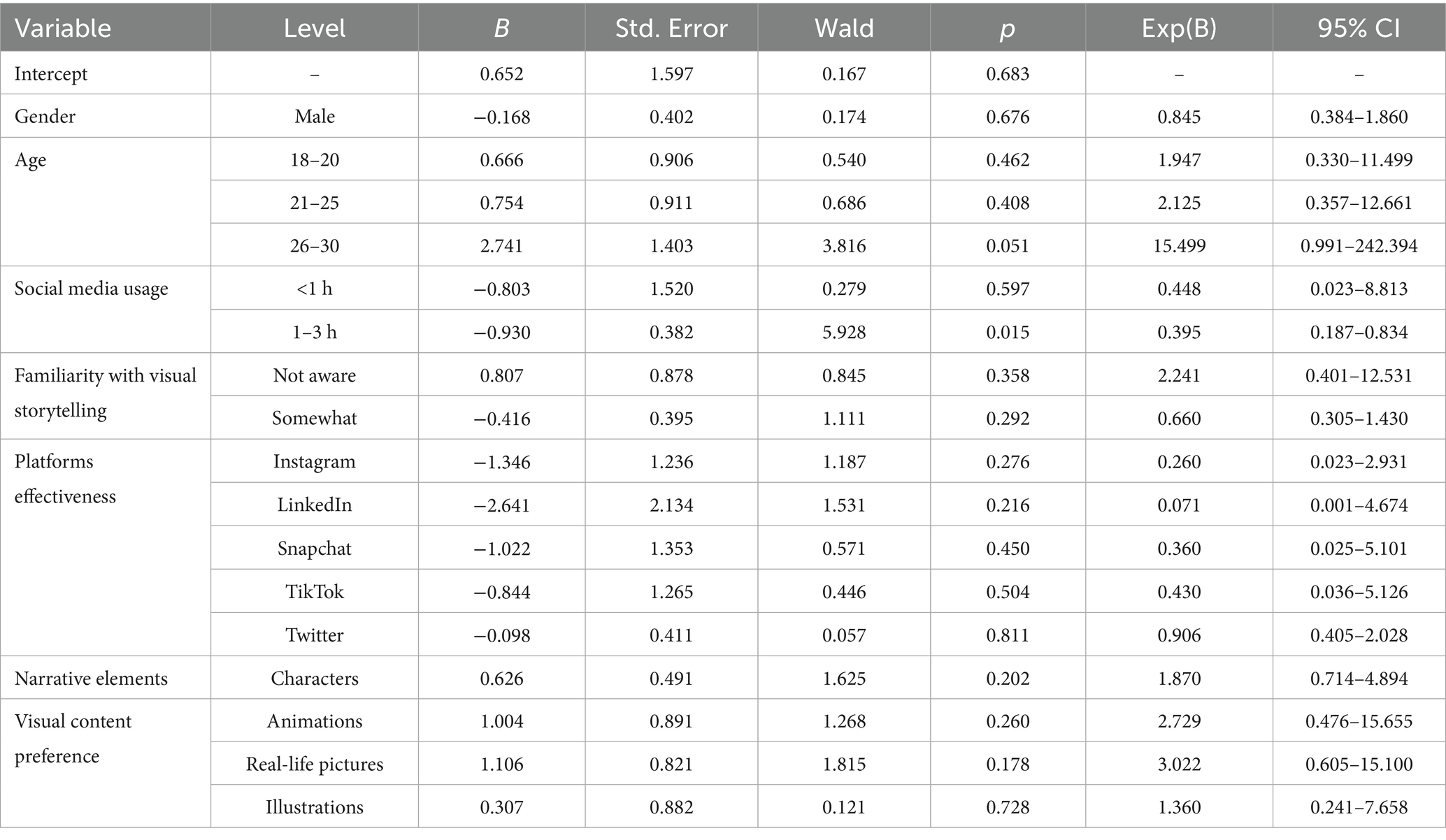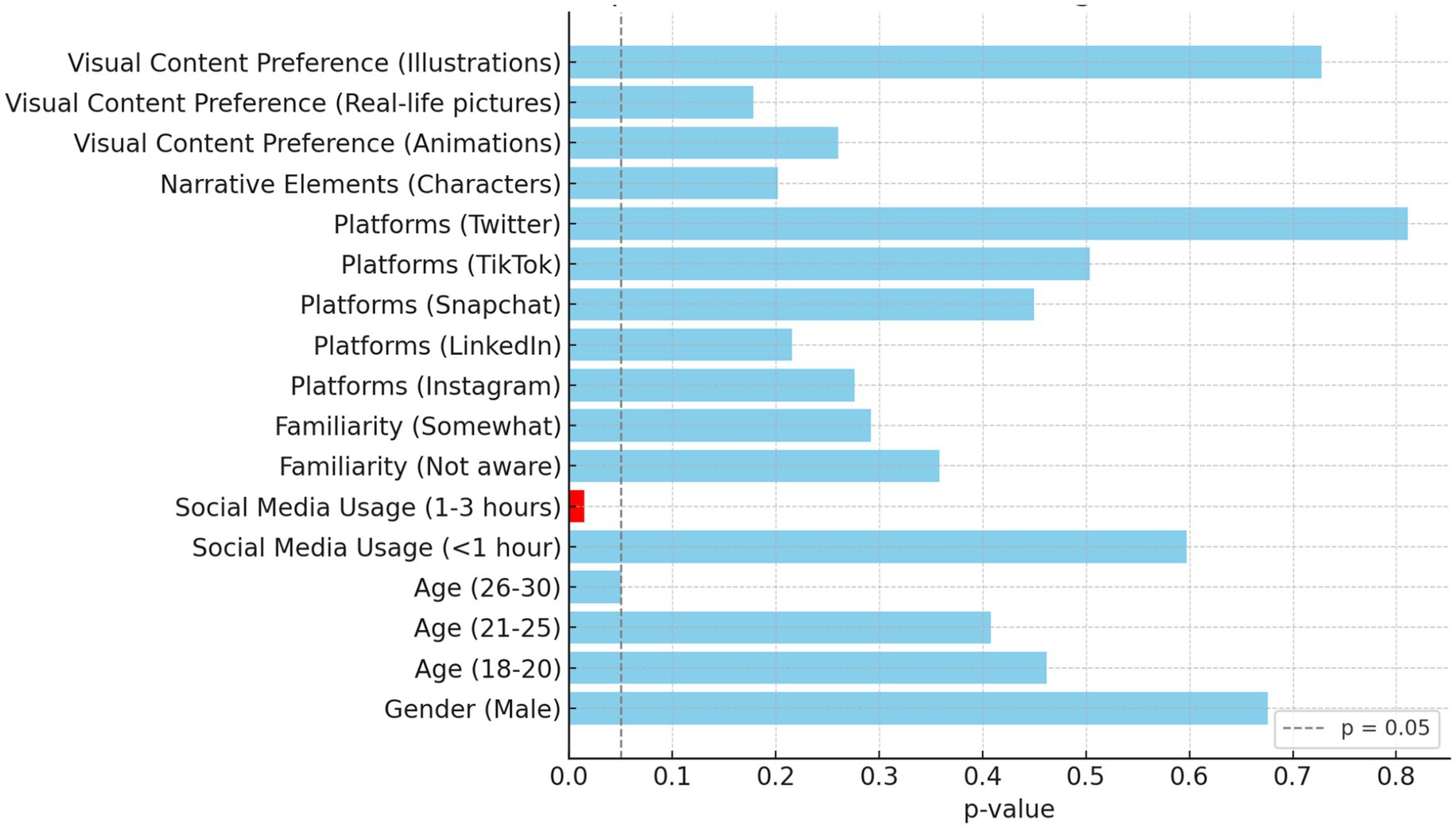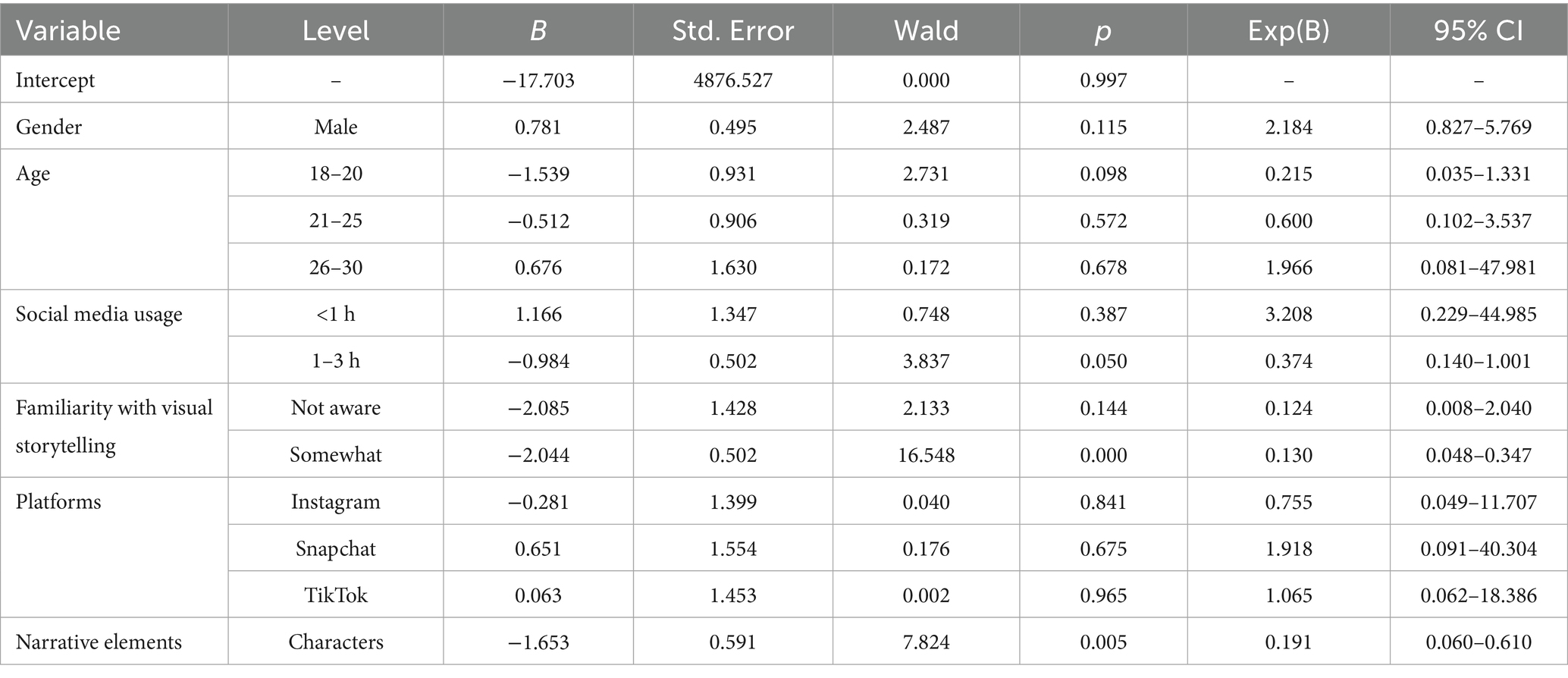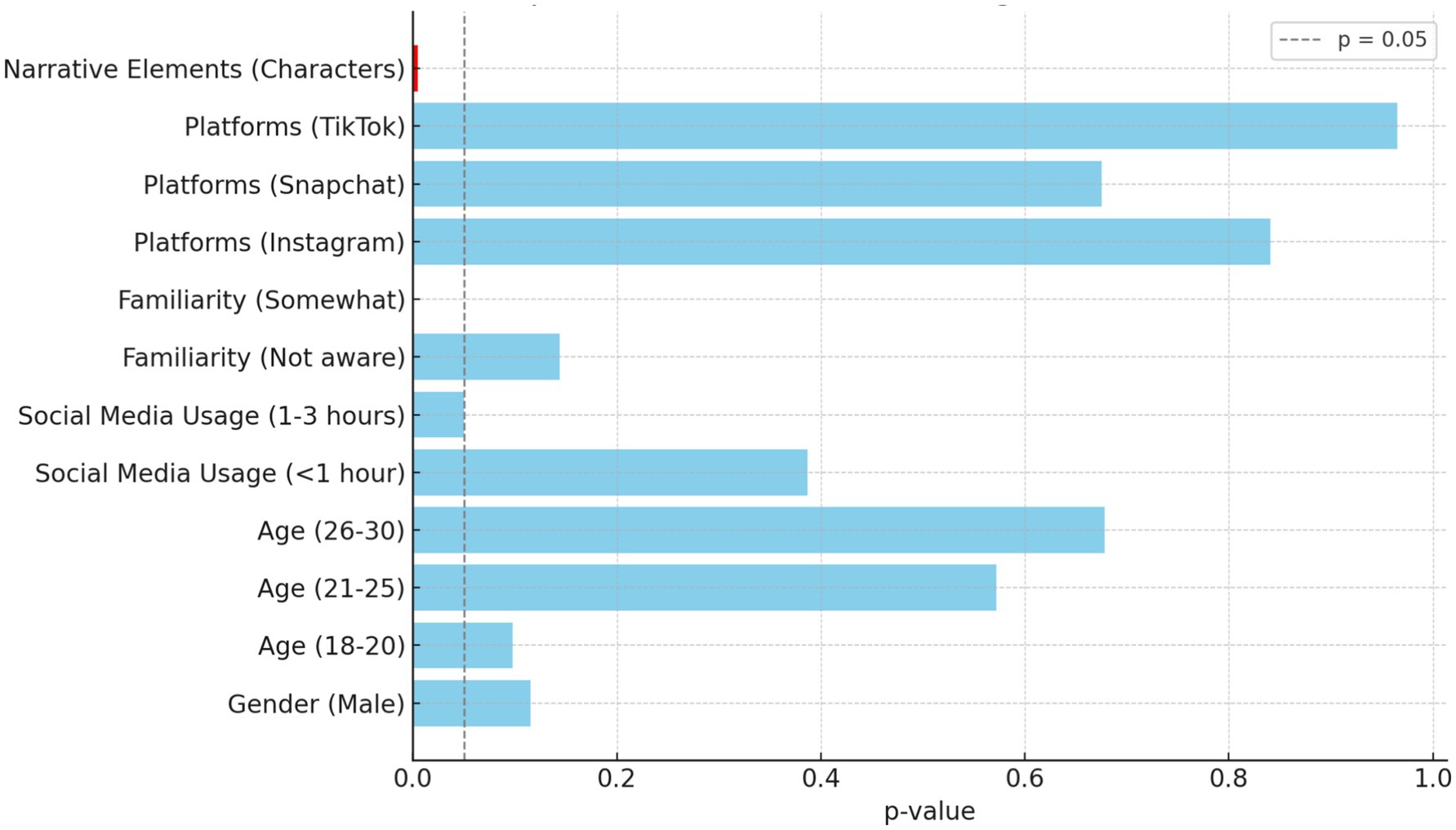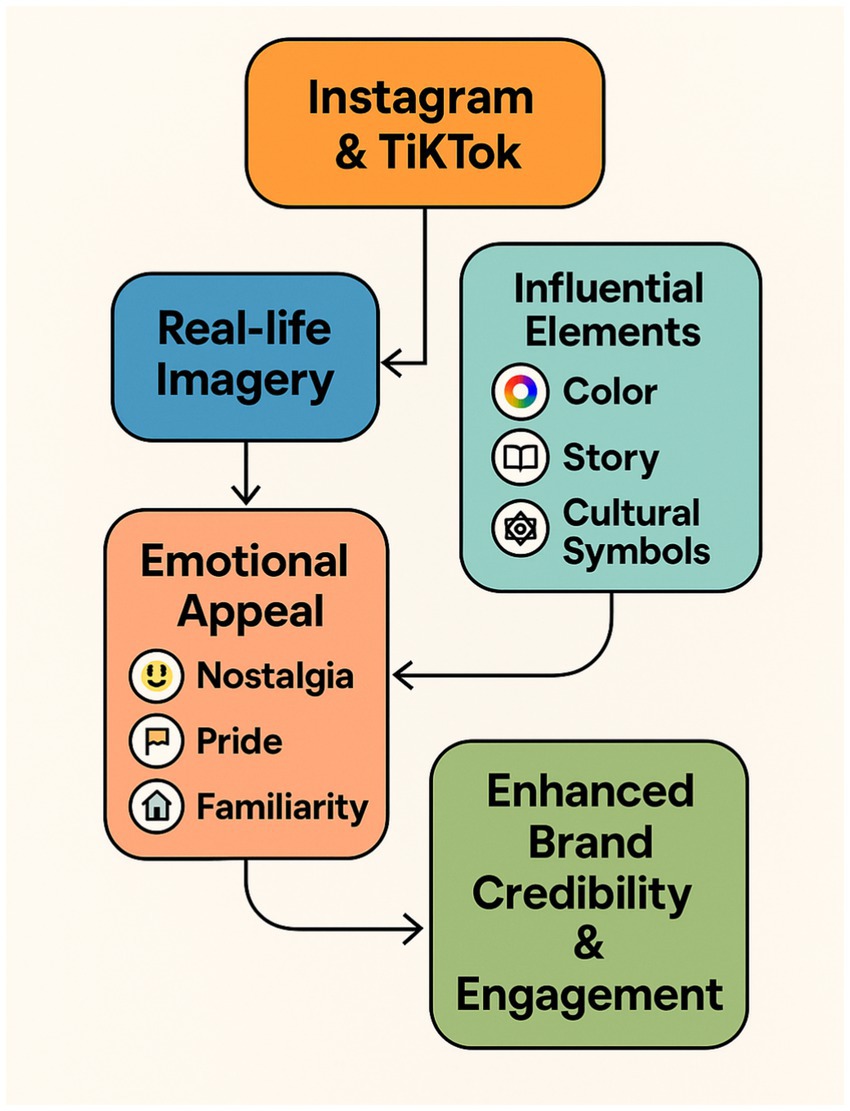- College of Mass Communication, Ajman University, Ajman, United Arab Emirates
Introduction: Social media has transformed brand communication in the GCC, making culturally relevant visual storytelling essential for effective engagement.
Methods: A cross-sectional online survey was conducted among 231 participants across the six GCC countries to examine perceptions of visual storytelling in social media advertising.
Results: Findings revealed a strong preference for culturally aligned, narrative-driven visual content on platforms like Instagram and TikTok. Key elements such as color, authentic imagery, and cultural symbols significantly enhanced consumer trust and engagement.
Discussion: The study underscores the importance of culturally sensitive visual narratives in enhancing brand credibility and consumer loyalty in GCC markets.
1 Introduction
In today’s digital era, social media has revolutionized the way brands communicate with their audiences, becoming a vital instrument tool for advertising and consumer engagement (Malik, 2023; Mueller and Rajaram, 2022; Yang and Wang, 2024). The effectiveness of visual storytelling has become increasingly apparent, particularly in its capacity to captivate audiences and sustain engagement. Video content, for instance, surpasses static images and text in drawing consumer interest and holding their attention for longer periods (Prihatiningsih et al., 2024). Beyond engagement, storytelling through visuals also facilitates emotional resonance, enabling brands to communicate complex messages and evoke strong emotions, which can enhance customer satisfaction and loyalty (Prihatiningsih et al., 2024).
In the context of brand versus product storytelling, product-focused narratives often yield broader appeal and positively influence customer evaluations across diverse metrics. In contrast, brand storytelling proves more effective within specific contexts, particularly when narratives are tailored to meet consumer needs and enrich online experiences, as seen in e-commerce settings (Garczarek-Bak et al., 2024). On social media, storytelling techniques can make corporate social responsibility initiatives feel more relatable, positively shaping stakeholder attitudes toward the brand (Santos et al., 2024). Additionally, embedding sustainability into storytelling aligns brands with environmentally conscious consumers, reinforcing brand identity and appeal in the process (Surmanidze et al., 2024).
Youth engagement and social media trends are particularly impactful in the Gulf Cooperation Council (GCC), where one of the highest youth populations globally and extensive social media usage make it an ideal target for digital marketing (Parvez, 2019). Platforms like TikTok and Instagram are especially popular among young users in the region, who are not only active in content creation but also in sharing, significantly influencing advertising trends (Hurley, 2023).
In this context, cultural sensitivity in advertising is crucial; to resonate with audiences, advertisements must align with local cultural and religious values, avoiding content that could be considered offensive (ElKhatib and Al-Ibrahim, 2023). Campaigns that successfully incorporate local narratives and aesthetics encourage a sense of community and belonging among viewers (Williams-Sanchez, 2021). Additionally, understanding consumer engagement through the lens of the Uses and Gratifications Theory can enhance how brands interact with audiences. Factors such as entertainment and trendiness have a major effect on audience interaction with content (Smith, 2024). By focusing on shareable, relatable content that encourages user participation and dialogue, advertisers can boost brand loyalty and foster a lasting connection with their audiences.
There is a notable gap in understanding how visual narratives affect consumer engagement and decision-making in the GCC, with most research focused on Western markets. This study aims to identify effective elements of visual storytelling in GCC advertising, particularly those that align with regional culture, values, and preferences. By examining how local symbols and narrative techniques impact consumer trust and brand perception, the research seeks to offer suggestions for more culturally attuned, effective advertising strategies that foster brand loyalty and engagement in the region.
2 Literature review
2.1 Visual storytelling in the digital era
The evolution of digital media has significantly transformed brand communication, particularly through the adoption of visual storytelling, which leverages the brain’s natural inclination to process images more effectively than text. This approach not only enhances the relatability and memorability of brand messages but also fosters emotional connections with consumers, as evidenced by studies highlighting its effectiveness in health advertising and consumer engagement (Andepam and Ugondo, 2024; Rao et al., 2024). The integration of dynamic visual elements, such as illustrations and motion graphics, further amplifies this impact by creating unique brand identities and facilitating deeper cognitive and emotional responses (Sharma and Chaturvedi, 2024; Yuan, 2024). Also, using different sensory elements in commercials has been shown to affect how consumers make decisions and feel, which helps strengthen their loyalty to and recognition of brands.
In the context of hyper-visual online environments, brands that leverage narrative-centric advertisements can significantly enhance their emotional resonance and consumer engagement. Research indicates that storytelling and metaphorical language in advertising foster stronger emotional connections, leading to improved brand recall and purchase intentions compared to traditional product-focused ads (Rigby and Lee, 2024). Furthermore, authenticity in brand narratives is crucial, as it establishes trust and credibility, particularly in sustainable branding efforts (Tariq, 2024). Small businesses, for instance, benefit from identity-focused storytelling, which cultivates brand trust more effectively than merely highlighting product attributes (Kim et al., 2024). Additionally, the integration of narrative design with visual elements enhances emotional consumption, aligning with evolving consumer expectations for deeper connections with brands (Bi, 2024).
2.2 Social media platforms as narrative conduits
The GCC region, with its youthful demographic and high social media engagement, presents a unique landscape for narrative-driven advertising, particularly on platforms like Instagram and TikTok. These platforms facilitate immersive storytelling that resonates with younger audiences, who favor multi-sensory experiences that entertain and inform while allowing for self-expression (Parvez, 2019b; Pripoae-Şerbănescu and Maţoi, 2023). The integration of brand stories into social media marketing has evolved, with brands no longer solely dictating narratives; instead, they engage with diverse voices, creating a collaborative storytelling environment (Dwivedi et al., 2021; Lund et al., 2018). TikTok, in particular, has emerged as a powerful tool for brand visibility and consumer interaction, leveraging native advertising and viral content to foster brand loyalty and awareness (Lund et al., 2018).
Research indicates that visual storytelling significantly enhances engagement on social media platforms, particularly within the context of the GCC region, where cultural nuances play a crucial role. Effective visual content, such as images and videos, fosters emotional connections and brand authenticity, as demonstrated by studies on various platforms like Instagram and Twitter, which highlight user interaction patterns and preferences for realistic visuals and dynamic formats (Kujur and Singh, 2020; Onyekuru, 2024). Moreover, understanding platform-specific behaviors is essential, as different social media environments exhibit unique community norms and interaction styles that influence narrative success (Lever and Elliot, 2023; Sutrisno et al., 2024). For instance, while Instagram thrives on visually compelling content that inspires travel and exploration, Twitter may facilitate more critical and debate-oriented discussions, particularly around pressing issues like climate change (Lever and Elliot, 2023).
2.3 Cultural alignment and authenticity in visual advertising
Cultural context significantly influences the effectiveness of advertisements in the Gulf Cooperation Council (GCC) region, where local audiences prioritize cultural authenticity in marketing narratives. Advertisements that incorporate recognizable symbols, traditional attire, and culturally relevant themes are perceived as more credible and trustworthy, enhancing brand identity and fostering consumer loyalty (Al-Hasan et al., 2022; Kushwah et al., 2019). Conversely, culturally incongruent or insensitive advertisements can lead to negative perceptions and alienation from the brand (Kelkar et al., 2024). The interplay between cultural values and consumer behavior necessitates that marketers carefully navigate these dynamics to avoid pitfalls and leverage local narratives effectively (Freer and Kherfi, 2020; Makkar, 2021).
2.4 The role of visual design elements: color, imagery, and semiotics
The micro-elements of visual storytelling, such as color palettes, imagery style, and multimedia components, significantly influence narrative tone and audience impact. Research indicates that color not only affects mood and memory retention but also shapes brand perception, with culturally congruent colors enhancing positive emotional responses and recall in advertisements (Lucas, 2022). Authentic imagery and semiotic elements play crucial roles in shaping consumer perceptions and fostering brand trust. Authenticity enhances brand love and image, which in turn drives positive word-of-mouth communication, as evidenced by research indicating that perceived brand authenticity significantly influences consumer engagement and attitudes (Yang et al., 2023; Yıldırım and Aydoğan, 2023).
Semiotic elements, like visuals and sounds, help quickly convey what a brand stands for, enhancing the sensory experience and shaping positive feelings about the brand. For instance, the psychological impact of color in design has been shown to alleviate mood disorders, highlighting the profound influence of multimedia elements on consumer emotions and brand relationships (Serazio et al., 2024; Yang et al., 2023). In the GCC context, the culturally inflected understanding of color, imagery, and symbolic references is likely distinct. For instance, certain colors may carry cultural significance, and images rooted in local landscapes or family scenes might yield greater resonance.
The integration of semiotic elements in visual narratives creates deeper cultural resonance, especially in markets with strong symbolic associations (Piccolo and Boero, 2024). Moreover, conveying authenticity through storytelling across different media channels has been shown to enhance brand trust and consumer engagement (Simon and Bontour, 2023). Similarly, multimodal approaches, including neurocopywriting strategies, have been identified as key drivers for digital commercial narratives (Voloshchuk and Glinka, 2023).
2.5 Consumer engagement, emotional resonance, and brand perception
Ultimately, the aim of culturally aligned, visually driven storytelling is to engender engagement, shape brand perceptions, and foster loyalty. Emotional resonance, such as nostalgia and pride, significantly motivates consumers to remember and interact with advertisements, leading to increased brand advocacy (Manoharan, 2024; Rigby and Lee, 2024). Narratives that reflect audience values and experiences can strengthen brand-consumer relationships, making brands feel integral to local identities, especially in culturally rich regions like the GCC (Choudhary and Sahu, 2023; Teraiya et al., 2023). Research indicates that storytelling and metaphorical language enhance emotional engagement, resulting in higher brand recall and purchase intentions (Rigby and Lee, 2024). Furthermore, effective brand storytelling promotes a sense of community and belonging, which is crucial for building brand love and loyalty (Dias and Cavalheiro, 2022).
3 Conceptual framework
Based on the reviewed literature, the following conceptual framework (Figure 1) illustrates the hypothesized relationship between visual storytelling, cultural alignment, emotional engagement, and brand outcomes in the context of GCC social media advertising.
4 Methods
4.1 Hypothesis
This study employed a quantitative, cross-sectional design using a structured online questionnaire to assess how visual storytelling in social media ads affects brand perception and consumer engagement in the GCC.
H1: In the GCC context, social media advertisements incorporating visual storytelling elements will elicit higher levels of consumer interest and memorability.
H2: GCC consumers will demonstrate higher engagement and brand preference when visual storytelling ads are delivered on visually oriented platforms (e.g., Instagram, TikTok) compared to less visual, text-heavy platforms.
H3: Social media ads that incorporate culturally relevant symbols, stories, and aesthetics will result in stronger emotional connections and enhanced brand credibility among GCC consumers compared to cultural neutral advertisements.
H4: The smart use of colors, images, and symbols that connect with the culture will greatly improve how well people remember ads, feel about them, and want to interact with them among GCC audiences.
H5: In GCC social media advertising, emotionally resonant, story-driven content that aligns with local cultural values will yield higher engagement, stronger brand perception, and increased brand loyalty compared to content lacking these culturally and narratively rich elements.
4.2 Ethical considerations
The study was conducted in compliance with ethical standards, including the Declaration of Helsinki, to ensure the protection of participants’ rights and privacy. Ethical approval was secured from the Research Ethics Committee of Ajman University under the approval number “Ma-F-H-7-Jan” on “7/1/2025.” During the survey period from “7/1/2025″ to “30/1/2025,” participants provided digital informed consent after being thoroughly informed about the study’s purpose, procedures, and significance. They were assured of their right to withdraw from the study at any point without any negative consequences. All collected data were anonymized to maintain confidentiality and protect personal information.
4.3 Study setting and participant demographics
Convenience sampling allowed researchers to easily collect data from willing participants. We gathered most of the responses through familiar online platforms like Instagram, WhatsApp, and email. This approach worked especially well for connecting with a younger, digitally active audience, which fits perfectly with the study’s focus on frequent social media users.
In addition, conducting probability sampling in the GCC region comes with several practical challenges. These include differences in language, variations in internet access, and limited availability of centralized population data. To apply a probability-based approach across six different countries would have required a significant amount of time, funding, and institutional coordination resources that were beyond what this study could support.
4.4 Measurement instrument
Data were collected using a structured online questionnaire disseminated via Google Forms. The questionnaire was designed to assess participants’ demographics, social media usage habits, familiarity with visual storytelling, and perceptions of visual narrative elements in advertising. The instrument was organized into several key sections. The demographic information section included questions regarding age, gender, and the amount of time spent on social media daily. The familiarity with visual storytelling section measured participants’ awareness and understanding of visual storytelling design in social media advertising. The perceptions of visual narrative elements section involved Likert-scale questions evaluating the importance and effectiveness of various visual elements, such as color, imagery, semiotics, and cultural references in advertisements. Lastly, the Cultural Influence on Advertising section explored how the cultural context influences participants’ perceptions of visual narratives and their likelihood of engaging with culturally aligned advertisements.
The questionnaire comprised a mix of closed-ended questions, multiple-choice items, and Likert-scale statements ranging from “Strongly Disagree” to “Strongly Agree.” It was developed based on existing literature in visual storytelling and advertising and was reviewed by experts in visual communication, marketing, and cultural studies to ensure content validity and cultural appropriateness.
4.5 Data analysis
The data analysis was conducted using SPSS version 27.0 (SPSS Inc., Chicago, IL, USA). Descriptive statistics were applied to characterize the sample and assess the score distributions. Attitude scores were calculated by summing responses, with each item scored on a scale from 0 to 3, resulting in a total possible score of up to 90. Scores were categorized as follows: ‘Low’ for values up to the 25th percentile (scores ≤ 75), ‘Medium’ for values between the 25th and 75th percentiles (scores 76–86), and ‘High’ for values above the 75th percentile (scores > 86).
Normality was tested using the Kolmogorov–Smirnov and Shapiro–Wilk tests. Differences in scores based on sociodemographic factors were analyzed through Mann–Whitney and Kruskal–Wallis tests. Spearman’s rank correlation was also utilized. Finally, a multiple linear regression model was applied, using scores as the dependent variable and incorporating various sociodemographic characteristics, behaviors, and participant attributes as predictors. All statistical analyses were conducted with a 95% confidence interval, and a significance level was set at p < 0.05.
5 Results
5.1 Demographics
Table 1 provides a summary of participant demographics. In total, 231 individuals participated in the survey. In terms of gender distribution, a larger portion of respondents identify as female (60.6%), while the remaining respondents identify as male (39.4%). The age range shows that most participants are between 18 and 20 years old (46.8%), followed closely by those aged 21 to 25 (42.4%). Smaller groups fall within the 26 to 30 (5.2%) and 31 to 35 age ranges (5.6%).
Regarding daily social media usage, the majority report using social media for more than 3 h each day (69.3%). A smaller segment spends between one and 3 h daily (28.1%), and an even smaller group spends less than 1 h (2.6%). Familiarity with the concept of visual storytelling in social media advertising is relatively high, with nearly half of the respondents indicating they are “familiar” (46.8%) and another substantial portion identifying as “somewhat familiar” (47.2%). A small group reports being “not aware at all” of this concept (6.1%). When asked which narrative elements have the greatest emotional impact in social media advertisements, over half of the respondents select “story” as the most impactful element (51.1%). Characters also hold emotional significance for some respondents (27.3%), followed by photos (21.6%).
A majority of respondents (59.7%) view Instagram as the most effective social media platform for visual storytelling in GCC advertising. TikTok is also popular for visual storytelling (23.4%), followed by Snapchat (9.5%), Twitter (3.9%), Facebook (2.6%), and LinkedIn (0.9%). Preferences for visual content in social media ads show that “real-life pictures” are the most favored format (61.5%). Other preferences include animations (18.2%), illustrations (16.0%), and infographics (4.3%).
5.2 Response summary
Table 2 provides a detailed summary of participant responses to the survey. Respondents indicate the high importance of visual storytelling in social media advertising, with a substantial portion finding it “very important” for effective outreach in this region (71.9%). Additionally, many respondents consider visual design critical in influencing their engagement with an ad (73.2%). Sixty-three percent of respondents note that visual narratives, like those conveyed through images or videos, effectively influence purchase decisions.
In terms of brand credibility, more than half of the respondents state that an engaging visual narrative consistently improves their perception of a brand’s credibility (55.0%). Many regularly notice the use of symbols and signs (semiotics) in social media advertisements (57.6%), and a large group finds that messages conveyed through these semiotic elements are very clear (59.7%). Rhetorical elements like emotional and logical appeals are reported as convincing by a significant portion (58.9%).
Color is noted as a central element in visual design, with most respondents agreeing that it is the most important factor in social media ad design (86.6%). A large majority also agree that color plays a dual role: it enhances memory retention for products and advertisements (87.9%) and consistently captures audience attention (87.4%). Additionally, color significantly influences how advertisements are perceived (87.0%) and contributes to creating a positive impression of the product (78.8%). Regarding imagery, a significant number of respondents prefer photographs over illustrations (61.5%). Many observe that unusual and composite images are particularly attention-grabbing (73.2%). Dramatic and emotional images also have a high impact (62.3%). Meaningful images are perceived as enhancing understanding (80.5%), while infographics are viewed as advantageous for retaining ad content (79.2%).
Multimedia elements like animation, human voices, and music also play a role in ad engagement. Many respondents agree that animations convey messages quickly (76.2%), a human voice enhances focus (66.2%), and music significantly affects the perception of the ad’s message (75.8%). Cultural relevance holds notable importance, with a majority of respondents finding visual storytelling important when targeting a GCC audience (75.8%) and reporting an emotional connection to ads with strong visual storytelling (73.6%). Additionally, respondents frequently experience emotional responses to ads that encourage interaction with the content (67.5%).
Cultural alignment also emerges as a priority. Many respondents consider it important for ads to reflect their cultural values (71.4%) and are likely to interact with ads that resonate with their local traditions (69.3%). Respondents often engage with ads featuring GCC cultural references (58.9%). The cultural background of a notable group consistently influences their purchasing decisions after viewing visually appealing ads (57.1%).
5.3 Participant characteristics scoring
The Kolmogorov–Smirnov and Shapiro–Wilk tests both show significant results (p < 0.05), indicating that the distribution significantly deviates from normality. Table 3 provides an overview of differences in participant scoring based on their characteristics. Among the participants, males constitute 43.1% in the low group, 33.3% in the medium group, and 48.2% in the high group. Females make up 56.9% of the low group, 66.7% of the medium group, and 51.8% of the high group. The p-value for gender differences is 0.487.
The age distribution reveals that 51.7% of individuals aged 18–20 fall into the low group, 51.3% into the medium group, and 32.1% into the high group. For those aged 21–25, 39.7% are in low, 38.5% in medium, and 53.6% in high. Participants aged 26–30 and 31–35 show minimal representation in the low and medium groups, with only 1.7 and 6.9%, respectively, in low, and 7.7 and 2.6% in medium. The p-value here is 0.171. A significant difference is observed in daily social media usage (p = 0.006). In the low group, 1.7% use social media for less than 1 h daily, 43.1% for 1 to 3 h, and 55.2% for more than 3 h. The medium group shows 0.9% using less than 1 h, 23.9% for 1 to 3 h, and a substantial 75.2% for over 3 h. In contrast, the High group has 7.1% using less than 1 h, 21.4% for 1 to 3 h, and a dominant 71.4% for more than 3 h.
Familiarity with visual storytelling in social media advertising also differs significantly across groups (p = 0.003). In the low category, 3.4% are not aware at all, 62.1% are somewhat familiar, and 34.5% are familiar. The medium group has 9.4% not aware, 48.7% somewhat familiar, and 41.9% familiar. The High group shows a marked decrease in unawareness (1.8%) and partial familiarity (28.6%), with 69.6% being familiar with the concept. We find no significant differences (p = 0.757) when evaluating which platforms effectively use visual storytelling design in GCC countries. All groups recognize Instagram the most, with 67.2% in Low, 55.6% in Medium, and 60.7% in High. Other platforms like Facebook, LinkedIn, Snapchat, TikTok, and Twitter show varied but non-significant usage rates.
The choice of narrative elements that have the greatest emotional impact varies significantly across groups (p = 0.002). In the low group, 37.9% prioritize characters, 17.2% photos, and 44.8% story. The Medium group leans slightly more towards story (45.3%) and characters (29.1%), while the High group predominantly emphasizes story (69.6%), with only 12.5% focusing on characters and 17.9% on photos. Preferences for types of visual content in social media advertisements show highly significant differences (p < 0.001). Real-life pictures are the most preferred across all groups, with 50.0% in Low, 59.0% in Medium, and a substantial 78.6% in High. Animations and illustrations are less favored, especially in the High group, which shows only 10.7% preference for each. Infographics are least preferred, with 6.9% in the low group, 5.1% in the medium group, and none in the high group.
5.4 Correlation analysis
Table 4 and Figure 2 provide a detailed summary of the correlation analysis. Gender exhibited a negligible and non-significant correlation with the attitude scores (r = −0.046, p = 0.488). Age demonstrated a positive and statistically significant correlation (r = 0.138, p = 0.036). The number of hours spent using social media daily was positively correlated (r = 0.137, p = 0.037). Familiarity with the concept of visual storytelling design in social media advertising showed a moderate positive correlation (r = 0.191, p = 0.004).
Social media platforms that utilize visual storytelling design for advertising in GCC countries show a very weak and non-significant correlation with the attitude scores (r = 0.054, p = 0.413). Among the narrative elements with the greatest emotional impact in social media advertisements, there was a moderate positive correlation (r = 0.234, p < 0.001). Lastly, the preference for types of visual content in social media advertisements exhibited a weak and non-significant negative correlation (r = −0.079, p = 0.234).
5.5 Visual correlation heatmap
To provide an intuitive understanding of the strength of associations between key visual storytelling elements and brand trust, Figure 3 presents a correlation heatmap. The heatmap highlights positive relationships between real-life imagery, symbolism, emotional appeal, and the degree of consumer trust in social media advertising. The color gradient visually emphasizes the relative strength of each association.
5.6 Regression analysis
Table 5 and Figure 4 provide a detailed summary of the regression for the medium group. Gender did not have a significant impact on attitudes towards visual storytelling. Specifically, being male was associated with a non-significant decrease in the attitude score (B = −0.168, Wald = 0.174, p = 0.676), with an odds ratio (Exp(B)) of 0.845 (95% CI: 0.384–1.860).
Age showed varying associations with attitudes. Participants aged 18–20 exhibited a positive but non-significant relationship (B = 0.666, Wald = 0.540, p = 0.462), with an Exp(B) of 1.947 (95% CI: 0.330–11.499). Similarly, those aged 21–25 had a positive, non-significant effect (B = 0.754, Wald = 0.686, p = 0.408) with an odds ratio of 2.125 (95% CI: 0.357–12.661). Participants aged 26–30 approached statistical significance (B = 2.741, Wald = 3.816, p = 0.051), indicating a substantial positive association (Exp(B) = 15.499, 95% CI: 0.991–242.394). Social media usage demonstrated significant effects for certain categories. Participants using social media for 1–3 h per day had a significant negative association with their attitude towards visual storytelling (B = −0.930, Wald = 5.928, p = 0.015), resulting in an Exp(B) of 0.395 (95% CI: 0.187–0.834). This result suggests lower positive attitudes compared to those using social media for more than 3 h per day, which was the reference category. Usage of less than 1 h per day was not significant (B = −0.803, Wald = 0.279, p = 0.597).
Familiarity with visual storytelling presented mixed results. Participants who were not aware of visual storytelling had a non-significant positive association (B = 0.807, Wald = 0.845, p = 0.358) with an Exp(B) of 2.241 (95% CI: 0.401–12.531). Conversely, those who were somewhat familiar exhibited a non-significant negative effect (B = −0.416, Wald = 1.111, p = 0.292) with an odds ratio of 0.660 (95% CI: 0.305–1.430).
Regarding narrative elements, the inclusion of characters was not significantly associated with attitudes towards visual storytelling (B = 0.626, Wald = 1.625, p = 0.202), yielding an Exp(B) of 1.870 (95% CI: 0.714–4.894). Finally, the preferences for animations and real-life pictures did not show a significant link to how people feel about visual storytelling. Preferences for illustrations (B = 0.307, Wald = 0.121, p = 0.728, Exp(B) = 1.360, 95% CI: 0.241–7.658) were also non-significant.
Table 6 and Figure 5 provide a detailed summary of the regression of the high group. Gender did not significantly impact attitudes towards visual storytelling. Specifically, being male was associated with a non-significant increase in the attitude score (B = 0.781, Wald = 2.487, p = 0.115), with an odds ratio (Exp(B)) of 2.184 (95% CI: 0.827–5.769). Age demonstrated varied associations with attitudes. Participants aged 18–20 showed a slightly negative relationship with the attitude score, but it wasn’t strong enough to be considered significant (B = −1.539, Wald = 2.731, p = 0.098), with an odds ratio of 0.215 (95% CI: 0.035–1.331). Those aged 21–25 also showed a non-significant negative effect (B = −0.512, Wald = 0.319, p = 0.572) with an odds ratio of 0.600 (95% CI: 0.102–3.537). On the other hand, participants aged 26–30 showed a non-significant positive relationship (B = 0.676, Wald = 0.172, p = 0.678) with an odds ratio of 1.966 (95% CI: 0.081–47.981).
Social media usage revealed some noteworthy findings. Participants who used social media for 1–3 h a day showed a nearly significant negative relationship (B = −0.984, Wald = 3.837, p = 0.050), leading to an Exp(B) of 0.374 (95% CI: 0.140–1.001). This result suggests a potential decrease in positive attitudes compared to those using social media for more than 3 h per day, which was the reference category. Usage of less than 1 h per day was not significant (B = 1.166, Wald = 0.748, p = 0.387), with an odds ratio of 3.208 (95% CI: 0.229–44.985).
Familiarity with visual storytelling presented mixed results. Participants who were somewhat familiar with visual storytelling had a significant negative association (B = −2.044, Wald = 16.548, p = 0.000), yielding an Exp(B) of 0.130 (95% CI: 0.048–0.347). Conversely, those who were not aware of visual storytelling showed a non-significant negative effect (B = −2.085, Wald = 2.133, p = 0.144) with an odds ratio of 0.124 (95% CI: 0.008–2.040). In evaluating platform effectiveness, most platforms did not show significant effects compared to the reference category. Regarding narrative elements, the inclusion of characters was significantly associated with attitudes towards visual storytelling (B = −1.653, Wald = 7.824, p = 0.005), resulting in an Exp(B) of 0.191 (95% CI: 0.060–0.610).
5.7 Visual summary of key findings
To visually synthesize the statistical findings, Figure 6 presents a summary of key participant preferences and their relationships. This infographic highlights the dominant platforms, preferred content types, influential visual elements, emotional responses, and the overall impact on brand perception in GCC social media advertising.
6 Discussion
The demographic profile of survey participants highlights a young, predominantly female audience that is highly engaged with social media, suggesting a strategic advantage for advertisers targeting this demographic through digital platforms (AlAfnan, 2024; Sharma and Ashfaq, 2023). Given that younger audiences demonstrate high daily engagement on social media, often exceeding 3 h, brands have an opportunity to leverage this consistent exposure to build familiarity and reinforce brand messages. These demographic insights imply that for brands seeking to capture this segment, social media platforms should serve not just as occasional points of contact but as central elements of a continuous brand presence (Prihatiningsih et al., 2024). For marketers, the demographic characteristics and high engagement of this group present the ideal conditions to deploy immersive and frequent storytelling campaigns, as Generation Z shows a strong emotional connection to brands that utilize storytelling effectively (Feng et al., 2024).
The level of familiarity with visual storytelling among respondents indicates a sophisticated audience receptive to advanced advertising strategies that go beyond basic product promotion. Nearly all participants reported at least some awareness of visual storytelling in advertising, with many expressing a deep familiarity. This familiarity suggests that audiences are likely to engage with ads that offer compelling narratives, as storytelling enhances brand personality and emotional connection (Lu et al., 2023). Given this, brands should prioritize depth and creativity in narrative construction, crafting ads that engage viewers with layered and relatable stories that go beyond explicit product messaging (Tariq, 2024). Additionally, the strong preference for story-driven content over static visuals underscores the value of narrative as a primary driver of emotional impact (Bi, 2024; Tariq, 2024). These preferences imply that advertisements that weave a relatable, compelling story will more effectively capture attention and foster emotional connections, making the audience more likely to remember and engage with the brand (Bi, 2024; Chen et al., 2024; Tariq, 2024).
The analysis of platform preferences highlights that Instagram and TikTok are perceived as the most effective channels for visual storytelling in GCC advertising, indicating that audiences associate these platforms with impactful narrative delivery. Instagram’s visually oriented design fosters substantial user engagement, a quality leveraged by public health ministries in the GCC to communicate effectively during the COVID-19 pandemic (Elhersh et al., 2024). Many posts align with the Crisis and Emergency Risk Communication framework, underscoring Instagram’s capability to deliver critical information through compelling visuals (Elhersh et al., 2024). These platforms are inherently designed for quick, visually engaging content, which aligns well with the viewing behaviors and expectations of this demographic. For brands, these insights suggest that Instagram and TikTok should be focal points for campaigns that prioritize visual storytelling, given their widespread acceptance and familiarity among users in this region.
The preference for real-life images in social media advertisements underscores an audience that values authenticity, highlighting a trend toward realism and transparency that resonates strongly with consumers (Elqadhi, 2024). Advertisements featuring genuine, everyday scenes tend to foster trust and relatability, indicating that authenticity plays a pivotal role in connecting with audiences who prioritize relatable, socially validating content. This strategic emphasis on transparency and real-world relevance often takes precedence over highly stylized or edited visuals, particularly when appealing to audiences that seek social validation through relatable experiences. Authenticity, encompassing both originality and truthfulness, is essential for social media influencers in maintaining credibility (Massi et al., 2024). Research demonstrates that audiences are more inclined to trust influencers who present themselves authentically, which significantly enhances their persuasive impact (Yang and Wang, 2024). Brands that partner with authentic influencers can not only boost their visibility but also build deeper connections with consumers (Zhou, 2023).
Color plays a crucial role in social media ad effectiveness, going beyond attracting attention to aid memory and create positive impressions. Thoughtfully chosen color schemes reinforce brand identity and boost ad memorability. Using nontraditional visuals can also help ads stand out, encouraging advertisers to engage viewers with unique imagery. Colors evoke specific emotions—red and yellow suggest energy, while blue conveys calmness (Awad et al., 2024). Studies show colors like yellow enhance brand perception (Shagyrov and Shamoi, 2024), and research links red and yellow to increased purchase decisions in confectionery ads (Zaiddi and Ismail, 2023). Complex visuals paired with strategic colors can further boost viewer engagement (Popovski et al., 2024).
Cultural relevance is essential in shaping audience perceptions, as ads that align with local values and traditions are more engaging. This is especially important in culturally rich regions like the GCC, where ads featuring local symbols or traditional attire create emotional connections. For brands, localization should extend beyond language to include culturally resonant visuals, fostering familiarity, respect, and brand loyalty. Brands that reflect local culture gain trust and acceptance, enhancing loyalty (Jahns, 2023). Understanding cultural nuances is key for authentic connections, as adapting marketing to local beliefs boosts engagement (Jahns, 2023; Malik, 2023). A culturally relevant approach addresses cultural blind spots and resonates with target audiences (Williams-Sanchez, 2021).
Research indicates that highly engaged social media users prefer creative, story-driven ads. Familiar with digital content, these users expect more than simple ads, making polished storytelling with dynamic visuals and immersive narratives more effective. Such users seek subjective, identity-resonant experiences, favoring content that engages emotionally and cognitively (San et al., 2020). Ads that evoke strong emotions foster brand loyalty (Nicoli et al., 2022), and narrative-driven approaches outperform product-focused ones in boosting brand perception (Lim and Childs, 2016). Quality storytelling with complex plots and emotional themes is essential for capturing and retaining these experienced audiences (Mueller and Rajaram, 2022).
The findings demonstrate that compelling visual storytelling increases consumer engagement and fosters emotional trust within social media advertising. Rather than simply boosting brand awareness, these strategies appear to shape brand perception and cultivate a sense of trust among audiences—an adjustment from the previous focus. Furthermore, aligning visual elements with the cultural context of the target audience proves essential in influencing how consumers respond. Overlooking this cultural connection may undermine the overall effectiveness of the advertising effort.
The results of this study may be applied by advertisers working in the Gulf Cooperation Council (GCC). Participants repeatedly stated a preference for graphics using genuine cultural symbols and tales. For example, pictures showing Gulf robes/headdresses were seen sharing the same emotional range of landscapes, including deserts and seashores. Or items such as a dallah (a pot for serving Arabic coffee), camels, and falcons also aroused interest and provided some degree of attached-ness. “Nostalgic” advertisements, those that made people think of their country’s past and how we had all been at one time or another very small embers burning gently in the life of a nation, not only boosted brand recognition but also held consumer attention.
6.1 Strengths and limitations
Certain limitations temper the study’s applicability across broader contexts. The reliance on convenience sampling through digital platforms may introduce selection bias, limiting the generalizability of results to all GCC demographics—particularly those less active on social media. Additionally, the cross-sectional design, which captures data at a single point, may not account for evolving social media trends or shifts in consumer preferences. While the sample predominantly consists of young adults, a broader age distribution could improve our knowledge about age-based differences in visual storytelling reception. Furthermore, the use of self-reported data introduces potential bias stemming from participants’ subjective assessments of engagement and brand perception. Despite these limitations, the study’s focus on a high-engagement, digitally active demographic aligns with the primary audience targeted by social media advertising campaigns in the GCC. This focus renders the findings relevant for advertisers operating within this regional context. To strengthen future research, longitudinal studies could be employed to track changes in consumer preferences and storytelling effectiveness over time, particularly as social media platforms continue to evolve. Comparative research between GCC and non-GCC MENA countries could help reveal regional nuances in cultural alignment and narrative effectiveness. Additionally, incorporating qualitative approaches such as in-depth interviews, focus groups, or visual content analysis would offer greater clarity about how consumers interpret and emotionally respond to visual storytelling. Finally, using experimental research methods, like A/B testing different story elements (for example, images versus illustrations), could help identify how specific parts of visual storytelling affect how consumers engage with a brand and how they see it.
7 Conclusion
This research puts an accentuation on the influential role that culturally attuned visual storytelling continues to play in determining social media engagement in the GCC. The findings confirm that the young, digitally literate consumers of the GCC are most highly responsive to advertisements that are authentic, emotionally resonant, and grounded in local culture. Story-led campaigns with worldly imagery, vivid color tones, and familiar cultural symbols captured consumers’ imagination and built brand recall and faith, whereas content that was perceived as generic, too commodified, or culturally disconnected was unable to sustain consumers’ interest. The platforms Instagram and TikTok, in particular, were highly effective media for delivering such engaging, worldly, pictorial narratives, in tune with their popularity among GCC consumers.
Theoretically, this study contributes to digital marketing and visual communications literature by demonstrating how the effectiveness of narrative advertising is mediated by cultural context. This study extends prior research—largely for Western markets—to a culturally rich GCC context and adds more emphasis that reception of visual content among audiences relies on cultural relevance and authenticity. These findings confirm communication models that highlight the importance of aligning brand communications with the values and experiences of the audience. In practice, the findings provide advertisers with clear advice: brands wishing to address GCC markets must undertake culturally sensitive storytelling methodologies that move beyond superficial localization. Practically, that means infusing campaign imagery with real local stories, symbols, and traditions, and emphasizing emotional storytelling strategies (e.g., nostalgia, pride, or family) that resonate directly with regional sentiment. By emphasizing authenticity and emotion, marketers can create more compelling content that not only grabs attention but also builds a sense of community and believability around the brand.
Looking outwards, non-GCC-based international businesses can maximize their regional impact by developing culturally sensitive visual narratives. Commissioning local cultural experts or creatives can help campaign imagery and narratives be both impactful and attuned to GCC social norms and values. These measures avoid faux pas like cultural stereotyping or tone-deaf communications, allowing global brands to engage with GCC consumers more meaningfully and customized. In essence, the practice implications highlight that blanket ads do not apply in culturally diverse regions; in fact, content-based adaptation to accommodate the cultural context is the practice vital to successful participation.
Lastly, creating brand loyalty in the GCC is based on authenticity, cultural relevance, and storytelling that hears the voice of the community. Visually sensitized storytelling, which is culturally attuned, is not merely a marketing tactic but a strategic imperative for creating long-term consumer relationships and optimizing brand loyalty within this dynamic, rapidly evolving marketplace.
Data availability statement
The original contributions presented in the study are included in the article/supplementary material, further inquiries can be directed to the corresponding author.
Ethics statement
The study was conducted in compliance with ethical standards, including the Declaration of Helsinki, to ensure the protection of participants’ rights and privacy. Ethical approval was secured from the Research Ethics Committee of Ajman University under approval number “Ma-F-H-7-Jan “on “7/1/2025.” During the survey period from “7/1/2025″ to “30/1/2025″ participants provided digital informed consent after being thoroughly informed about the study’s purpose, procedures, and significance. They were assured of their right to withdraw from the study at any point without any negative consequences. All collected data were anonymized to maintain confidentiality and protect personal information.
Author contributions
KM: Writing – original draft, Writing – review & editing.
Funding
The author(s) declare that financial support was received for the research and/or publication of this article. The Article Processing Charge (APC) for this publication was covered by Ajman University.
Conflict of interest
The author declares that the research was conducted in the absence of any commercial or financial relationships that could be construed as a potential conflict of interest.
Generative AI statement
The author(s) declare that no Gen AI was used in the creation of this manuscript.
Publisher’s note
All claims expressed in this article are solely those of the authors and do not necessarily represent those of their affiliated organizations, or those of the publisher, the editors and the reviewers. Any product that may be evaluated in this article, or claim that may be made by its manufacturer, is not guaranteed or endorsed by the publisher.
References
AlAfnan, M. A. (2024). Social media personalities in Asia: demographics, platform preferences, and behavior-based analysis. Stud. Media Commun. 12:349. doi: 10.11114/smc.v12i3.6925
Al-Hasan, S., Thomas, B., and Al-Marri, M. (2022). An investigation of cultural factors in the marketing and advertising of small and medium-sized enterprises (SMEs) in the Gulf cooperation council (GCC) countries. Int. J. Sci. Adv. 3, 469. doi: 10.51542/ijscia.v3i3.28
Andepam, M. D., and Ugondo, P. I. (2024). Digital storytelling in advertising: analysis of health advertisements in Nigeria. Int. J. Humanit. Educ. Soc. Sci. 2, 417–435. doi: 10.58578/ijhess.v2i3.4086
Awad, Z., Eida, M., Soliman, H., Alkaramani, M., Elbadwy, I., and Hassabo, A. (2024). The psychological effect of choosing colors in advertisements on stimulating human interaction. J. Text. Color. Polym. Sci. 22, 289–298. doi: 10.21608/jtcps.2024.259790.1323
Bi, M. (2024). Narrative brand design in the field of emotional consumption: take Guanxia brand as an example. Highlights Art Des. 6, 22–25. doi: 10.54097/yy2n8f93
Chen, T., Fan, X., He, J., Fan, J., and Chen, W. (2024). When “I” or “S/He” uses the product: the impact of narrative perspective on consumers’ brand attitudes in storytelling ads. Front. Psychol. 15:1338249. doi: 10.3389/fpsyg.2024.1338249
Choudhary, P. K., and Sahu, K. K. (2023). Managing and shaping brand associations to ensure positive alignment with “brand image”: narrative synthesis. Int. J. Phys. Educ. Sports Health 10, 112–117. doi: 10.22271/kheljournal.2023.v10.i3b.2935
Dias, P., and Cavalheiro, R. (2022). The role of storytelling in the creation of brand love: the PANDORA case. J. Brand Manag. 29, 58–71. doi: 10.1057/s41262-021-00254-6
Dwivedi, Y. K., Ismagilova, E., Hughes, D. L., Carlson, J., Filieri, R., Jacobson, J., et al. (2021). Setting the future of digital and social media marketing research: perspectives and research propositions. Int. J. Inf. Manag. 59:102168. doi: 10.1016/j.ijinfomgt.2020.102168
Elhersh, G. A., Khan, M. L., Malik, A., Al-Umairi, M., and Alqawasmeh, H. K. (2024). Instagram for audience engagement: an evaluation of the CERC framework in the GCC nations for digital public health during the Covid-19 pandemic. BMC Public Health 24:1587. doi: 10.1186/s12889-024-18957-1
ElKhatib, R., and Al-Ibrahim, F. A. H. I. (2023). The impact of social media on tourism in Qatar. Rev Int. Manag. Entrep. Commun. 10. doi: 10.59285/rimec.392
Elqadhi, M. (2024). The effectiveness of the realistic visual image in advertisements of official initiatives and its role in supporting community awareness. J. Des. Sci. Appl. Arts 5, 131–141. doi: 10.21608/jdsaa.2023.221881.1324
Feng, X., Wang, P., Wang, S., and Zhang, K. (2024). A study on the construction of brand storytelling and the emotional connection of generation Z. Finance Econ. 1, 6–9. doi: 10.61173/4qsan235
Freer, C., and Kherfi, Y., (2020). Whose story? Narratives of nationalism in heritage production of the Arabian Peninsula. London, UK: LSE Middle East Centre.
Garczarek-Bak, U., Szymkowiak, A., Jaks, Z., and Jansto, E. (2024). Impact of product vs. brand storytelling on online customer experience. Int. J. Wine Bus. Res. 36, 370–405. doi: 10.1108/IJWBR-07-2023-0041
Hurley, Z. (2023). Dubailiving and digital placemaking on TikTok: migrant, domestic, and service workers’ affective social mediascapes. Soc. Media Soc. 9:20563051231196897. doi: 10.1177/20563051231196897
Jahns, J. (2023). The future of marketing: how cultural understanding contributes to the success of brand positioning and campaigns. J. Digit. Soc. Media Mark. 11:225. doi: 10.69554/GDFD8618
Kelkar, A. P., Uddin, S. K. R., and Vasamsetty, P. S. (2024). Consumer perception variations and brand loyalty in diverse cultural contexts. Int. J. Multidiscip. Res. 6:16182. doi: 10.36948/ijfmr.2024.v06i02.16182
Kim, G., Jin, B.E., and Jo, H., (2024). Brand identity or product focus: small business video storytelling to build brand trust, in bridging the divide. Presented at the Bridging the Divide, Iowa State University Digital Press.
Kujur, F., and Singh, S. (2020). Visual communication and consumer-brand relationship on social networking sites—uses and gratifications theory perspective. J. Theor. Appl. Electron. Commer. Res. 15, 30–47. doi: 10.4067/S0718-18762020000100104
Kushwah, S., Shree, D., Rezaei, S., and Sagar, M. (2019). The impact of culture on consumers’s perception of brand identity: evidence from gulf countries. J. Islam. Mark. 11, 479–496. doi: 10.1108/JIMA-12-2017-0146
Lever, M. W., and Elliot, S. (2023). A picture is worth a thousand shares: the case of destination Canada’s social media visual storytelling campaign. J. Hosp. Tour. Cases 11, 10–15. doi: 10.1177/21649987231208765
Lim, H., and Childs, M. (2016). Brand storytelling on Instagram: how do pictures travel to millennial consumers’ minds? Ames: Iowa State University, Digital Repository.
Lu, M., Lu, Q., and Kahn, H. (2023). Brand storytelling: a review and agenda for future research. Inst. Glob. Bus. Res. 35, 1–33. doi: 10.46775/JGBR.2023.35.1.01
Lucas, R. (2022). “Color, culture, and the implications for emotional, cognitive, and behavioral reactions. ” LSU Master’ s Theses. 5688, 4–17. Available at: https://repository.lsu.edu/gradschool_theses/5688
Lund, N. F., Cohen, S. A., and Scarles, C. (2018). The power of social media storytelling in destination branding. J. Destin. Mark. Manag. 8, 271–280. doi: 10.1016/j.jdmm.2017.05.003
Makkar, M. (2021). “Using local culture in brand positioning and communication” in Marketing brands in Africa, Palgrave studies of Marketing in Emerging Economies. ed. S. Appau (Cham: Springer International Publishing), 171–201.
Malik, R. (2023). “Culture and its influence on elements of marketing mix” in Advances in marketing, customer relationship management, and E-services. eds. A. Singh, S. Sharma, A. Singh, M. Unanoglu, and S. Taneja (IGI Global), 123–130.
Manoharan, J. (2024). Navigating the digital marketing field: the role of AI and emotional storytelling in consumer engagement. Am. J. Comput. Sci. Technol. 7, 156–169. doi: 10.11648/j.ajcst.20240704.13
Massi, M., Piancatelli, C., Vocino, A., and Rojas-Méndez, J. I. (2024). Making it real on social media: exploring authenticity strategies for sport and fitness influencers. J. Strateg. Mark. 32, 1376–1397. doi: 10.1080/0965254X.2024.2341887
Nicoli, N., Henriksen, K., Komodromos, M., and Tsagalas, D. (2022). Investigating digital storytelling for the creation of positively engaging digital content. EuroMed J. Bus. 17, 157–173. doi: 10.1108/EMJB-03-2021-0036
Onyekuru, J. (2024). Exploring the power of images and videos in visual storytelling and content marketing: Airtel Ovajara as a paradigm. J. Creat. Media 1, 51–54. doi: 10.70553/pau.2024.1991.15
Parvez, Z. (2019). Youth and social media in GCC changing trends in communication, social participation and identity. Int. J. Soc. Sci. Interdiscip. Stud. 4, 5–18. doi: 10.1007/978-981-96-3412-5
Piccolo, R., and Boero, M. (2024). “Between digital experiential marketing and semiotics: the new spaces of consumption in Asia” in Advances in finance, accounting, and economics. eds. P. Ordóñez De Pablos, M. N. Almunawar, and M. Anshari (Milan, Italy: IGI Global), 196–213.
Popovski, F., Popovska, H. D., Mijakovska, S., and Nalevska, G. P. (2024). Psychological and graphic aspects of colors: influence and application in product design. Int. J. Comput. Sci. Inf. Technol. 16, 59–65. doi: 10.5121/ijcsit.2024.16305
Prihatiningsih, T., Panudju, R., and Prasetyo, I. J. (2024). Digital advertising trends and effectiveness in the modern era: a systematic literature review. Gold. Ratio Mark. Appl. Psychol. Bus. 4, 132–143. doi: 10.52970/grmapb.v4i2.505
Pripoae-Şerbănescu, C., and Maţoi, E. (2023). “Social media in the GCC countries—facilitator or curse for generation “Z”?” in Social change in the Gulf region: Multidisciplinary perspectives. eds. M. M. Rahman and A. Al-Azm (Singapore: Springer Nature), 17–39.
Rao, U., Ali, M., and Rubab, S. (2024). Unveiling the power of storytelling: a comparative analysis of consumer vs. brand narratives in shaping favorable attitudes toward brands through emotions and cognition. Int. J. Manag. Res. Emerg. Sci. 14:27. doi: 10.56536/ijmres.v14i3.609
Rigby, B. D., and Lee, R. (2024). Creating emotional resonance in advertising language strategies and consumer identity. J. Linguist. Commun. Stud. 3, 1–13. doi: 10.56397/JLCS.2024.09.01
San, K. O., Sade, A. B., and Seduram, L. (2020). Social networking brand engagement using creative brand content experiences. Int. Bus. Res. 13:63. doi: 10.5539/ibr.v13n4p63
Santos, S., Vasconcelos, M., Ferreira, S., Augusto, L., and Espírito Santo, P. (2024). “The role of social Media in Sustainable Branding: a systemic literature review” in Advances in marketing, customer relationship management, and E-services. eds. P. Rodrigues, A. P. Borges, E. Vieira, and V. Tavares (New York, USA: IGI global), 62–78.
Serazio, M., Pooley, J., and Timke, E. (2024). Key concepts in advertising: authenticity. Advert. Soc. Q. 25, 26–29. doi: 10.1353/asr.2024.a924353
Shagyrov, M., and Shamoi, P., (2024). Color and sentiment: a study of emotion-based color palettes in marketing.
Sharma, M. S., and Ashfaq, D. R. (2023). Targeting the digital consumer: a study of the role of social media in modern advertising. J. Humanit. Dance 3, 22–35. doi: 10.55529/jhmd.34.22.35
Sharma, R., and Chaturvedi, K. (2024). Exploring the impact of visual storytelling through illustrations in Indian advertising. ShodhKosh J. Vis. Perform. Arts 5, 297. doi: 10.29121/shodhkosh.v5.iICETDA24.2024.1343
Simon, F., and Bontour, A. (2023). Conveying brand authenticity through television advertising in a transmedia world. J. Mark. Manag. 39, 1645–1671. doi: 10.1080/0267257X.2023.2276249
Smith, S. P. (2024). # Nature is trending: social media, viral landscapes, and digital environmental activism in Oman. Int. J. Cult. Stud. 442–461. doi: 10.1177/13678779241268090
Surmanidze, N., Tskhadadze, K., and Amashukeli, M. (2024). “Compelling storytelling narratives” in Advances in marketing, customer relationship management, and E-services. eds. P. Rodrigues, A. P. Borges, E. Vieira, and V. Tavares (New York, USA: IGI global), 1–23.
Sutrisno, S., Ausat, A. M. A., and Muhamad, L. F. (2024). Effective social media content strategy to enhance brand loyalty in technology businesses. Malcolm Indonesia J. Mach. Learn. Comput. Sci. 4, 1261–1266. doi: 10.57152/malcom.v4i4.1416
Tariq, M. U. (2024). “Crafting authentic narratives for sustainable branding” in Advances in marketing, customer relationship management, and E-services. eds. P. Rodrigues, A. P. Borges, E. Vieira, and V. Tavares (New York, USA: IGI global), 194–229.
Teraiya, V., Namboodiri, S., and Jayswal, R. (2023). The impact of storytelling advertising on consumer advertising experiences and brand equity. GLIMS J. Manag. Rev. Transform. 2, 1–23. doi: 10.1177/jmrt.231160591
Voloshchuk, I. P., and Glinka, N. V. (2023). Multimodality and neurocopywriting as digital commercial narrative strategies. Alfred Nobel Univ. J. Philol. 2, 91–107. doi: 10.32342/2523-4463-2023-2-26/2-6
Williams-Sanchez, V. L. (2021). Culturally relevant marketing: conceptualizing a critical pedagogical approach to multicultural marketing strategy. J. Cult. Mark. Strategy 6:61. doi: 10.69554/FUQR8569
Yang, J., Jiang, M., and Kim, T. (2023). “Authentic warmth in these uncertain times”: the impact of authenticity in COVID-19 advertising on brand warmth and consumer responses. J. Promot. Manag. 29, 259–279. doi: 10.1080/10496491.2022.2143988
Yang, Y.-J., and Wang, C.-C., (2024). Authenticity of social media influencers: a literature review and bibliometric analysis, In: Presented at the 2024 joint international conference on digital arts, media, and technology with ECTI northern section conference on electrical, electronics, computer, and telecommunications engineering (ECTI DAMT NCON), IEEE, Chiang Mai, Thailand, pp. 280–285.
Yıldırım, M., and Aydoğan, S. (2023). An examination of the mediating role of BRAND love and BRAND image in the impact of BRAND authenticity on positive word-of-mouth communication. J. Res. Bus. 8, 640–662. doi: 10.54452/jrb.1370307
Yuan, P. (2024). Research on the dynamization effect of brand visual identity design: mediated by digital information smart media. J. Inf. Syst. Eng. Manag. 9:24153. doi: 10.55267/iadt.07.14078
Zaiddi, S. Z. A. A., and Ismail, Z. A. (2023). Effectiveness of color in gen z’s decision-making for confectionery brands on social media. Int. J. Art Des. 7, 87–100. doi: 10.24191/ijad.v7i2.1056
Keywords: visual storytelling, social media advertising, GCC, cultural relevance, consumer engagement, brand perception
Citation: Mohamed KMM (2025) Visual storytelling and cultural connection in GCC social media advertising. Front. Commun. 10:1584156. doi: 10.3389/fcomm.2025.1584156
Edited by:
Saif Ahmed, National University of Malaysia, MalaysiaReviewed by:
Ruba Saleh, Brussels Management School, BelgiumEka Perwitasari Fauzi, Mercu Buana University, Indonesia
Copyright © 2025 Mohamed. This is an open-access article distributed under the terms of the Creative Commons Attribution License (CC BY). The use, distribution or reproduction in other forums is permitted, provided the original author(s) and the copyright owner(s) are credited and that the original publication in this journal is cited, in accordance with accepted academic practice. No use, distribution or reproduction is permitted which does not comply with these terms.
*Correspondence: Khaled Mostafa M. Mohamed, ay5tb2hhbWVkQGFqbWFuLmFjLmFl
 Khaled Mostafa M. Mohamed
Khaled Mostafa M. Mohamed
